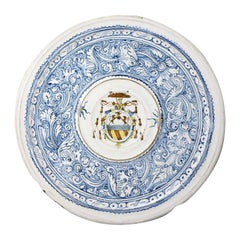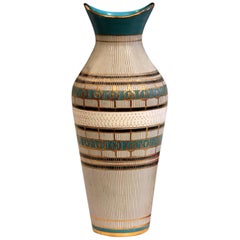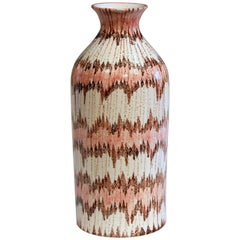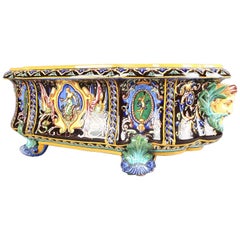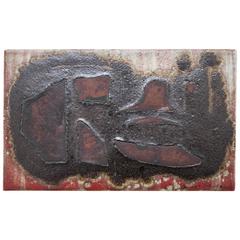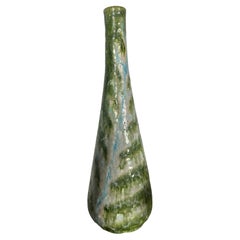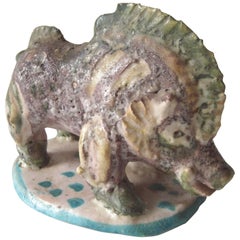Italian Pottery Marks
to
11
2
11
10
7
1
1
1
6
3
1
1
1
Sort By
Italian Renaissance Period Maiolica Dish with the Mark of Virgiliotto Calamelli
Located in Woodstock, OXFORDSHIRE
Circular Renaissance pottery dish with elaborate blue scrolling decoration, the center panel with a
Category
Antique 16th Century Italian Renaissance Ceramics
Materials
Ceramic, Pottery
Bitossi Seta Pottery Raymor Londi Italian Vase Vintage 1950s Early V Mark
By Bitossi
Located in Wilton, CT
Large and early V mark 1950s Bitossi Seta (silk) decor vase, circa 1950s. 14" high 6" diameter
Category
Vintage 1950s Italian Mid-Century Modern Vases
Materials
Pottery
Bitossi Italian Pottery Early V-Mark Londi Raymor Vase Vintage 1950s Ceramic
By Bitossi
Located in Wilton, CT
Early V-Mark 1950s Bitossi vase decorated with jagged electric current decor, circa 1950s. Measures
Category
Vintage 1950s Italian Mid-Century Modern Vases
Materials
Pottery
Antique Italian Faience Pottery Figural and Footed Planter Castle Gien Mark
By Gien
Located in Big Flats, NY
Antique Italian classical hand-painted Faience art pottery planter by Gien features shield or
Category
Antique 19th Century Italian Classical Greek Decorative Bowls
Materials
Faience
Rare Guido Gambone Art Pottery Plate with Donkey Mark and Signature
By Guido Gambone
Located in Munich, DE
Very rare Guido Gambone ceramic plate, with the original signature on the front and donkey mark on
Category
Vintage 1950s Italian Mid-Century Modern Ceramics
Materials
Ceramic
Guido Gambone Modernist Ceramic Pottery Vase, INK MARK , Italy "dONKEY"
By Guido Gambone
Located in Buffalo, NY
Stunning Guido Gambone Modernist Ceramic Pottery Bud Vase, INK MARKed , Italy "dONKEY" wonderful
Category
Vintage 1950s Italian Mid-Century Modern Vases
Materials
Pottery, Ceramic
MCM Italian Green Pottery Lamp by Raymor Attributed to Alvino Bagni
By Alvino Bagni, Raymor
Located in Topeka, KS
Very handsome large Mid-Century Modern Italian green mottled pottery lamp marked Raymor Italy and
Category
Mid-20th Century Italian Mid-Century Modern Table Lamps
Materials
Ceramic
Bitossi Italian Pottery Early V-Mark Londi Raymor Vase Vintage 1950s Ceramic
By Bitossi
Located in Wilton, CT
Early V-mark 1950s Bitossi vase decorated with jagged electric current decor, circa 1950s. Measures
Category
Vintage 1950s Italian Mid-Century Modern Vases
Materials
Pottery
Guido Gambone Ceramic/Pottery, Boar, Sculpture Stamped Signed Donkey Mark
By Guido Gambone
Located in Los Angeles, CA
Very nice and well-known sculpture by the well-known artist Guido Gambone.
Category
Vintage 1950s Italian Modern Ceramics
Materials
Ceramic, Pottery
Mid-Century Modern Italian Ceramic Rare Lamp Signed with Donkey Mark by Gambone
By Guido Gambone, The Marbro Lamp Company
Located in San Diego, CA
Beautiful and rare early ceramic table lamp in original condition, signed with donkey mark lamp by
Category
20th Century Italian Mid-Century Modern Table Lamps
Materials
Brass
MCM Italian Ceramic Pendant Ceiling Light Attributed to Alvino Bagni for Raymor
By Alvino Bagni
Located in Topeka, KS
and give us the lengths desired. Please see photos, circa 1950s-1960s.
Holy Italian pottery Batman
Category
Mid-20th Century Italian Mid-Century Modern Chandeliers and Pendants
Materials
Metal
H 30 in W 17 in D 17 in
Signed Guido Gambone and with a “donkey” Mark, 1950s
By Guido Gambone
Located in Hudson, NY
green lava glaze in a graphic decor on a transparent base. Signed Gambone and with a “donkey”-mark
Category
Vintage 1950s Italian Mid-Century Modern Table Lamps
Materials
Pottery
Pair of Italian Pottery Guido Gambone Donkey Mark Lava Glaze Vases
By Guido Gambone
Located in Tulsa, OK
Two wonderful Italian pottery vases, both signed Gambone Italy, with the figural donkey mark. Both
Category
Mid-20th Century Italian Mid-Century Modern Vases
Materials
Pottery
Get Updated with New Arrivals
Save "Italian Pottery Marks", and we’ll notify you when there are new listings in this category.
Italian Pottery Marks For Sale on 1stDibs
Find a variety of Italian pottery marks available on 1stDibs. Each of these unique Italian pottery marks was constructed with extraordinary care, often using ceramic, pottery and earthenware. There are 183 antique and vintage Italian pottery marks for sale at 1stDibs, while we also have 7 modern editions to choose from as well. Italian pottery marks have long been popular, with older editions for sale from the 18th Century and newer versions made as recently as the 21st Century. Italian pottery marks made by mid-century modern designers — as well as those associated with modern — are very popular at 1stDibs. Guido Gambone, Piero Fornasetti and Aldo Londi each produced beautiful Italian pottery marks that are worth considering.
How Much are Italian Pottery Marks?
The average selling price for at 1stDibs is $1,041, while they’re typically $49 on the low end and $188,843 highest priced.
Questions About Italian Pottery Marks
- 1stDibs ExpertFebruary 17, 2023To identify Italian pottery marks, you can try checking trusted online resources and databases. Search for a description of the mark or browse images to look for ones that match. Because it can be difficult to determine the authenticity of pottery, you may wish to seek the help of a certified appraiser who is knowledgeable about Italian makers. With respect to Italian porcelain, major manufacturers include Richard Ginori and Capodimonte (the latter was founded by King Charles VII of Naples). Beginning in the mid-18th century, porcelain made by King Charles VII’s factory was stamped with a fleur-de-lis, usually in underglaze blue. Pieces from Ferdinand’s were stamped with a Neapolitan N topped by a crown. When secondary manufacturers began production, they retained this mark, in multiple variations. Find a collection of Italian pottery on 1stDibs.
- 1stDibs ExpertNovember 26, 2024To identify vintage Italian pottery marks, you can research them yourself using trusted online resources or consult a certified appraiser or experienced antique dealer. One way to begin researching pottery marks on your piece is to take a photograph and then perform a reverse image search. If your search yields no results, type a description into a search engine or review image reference guides devoted to Italian pottery. Once you have identified the maker, learn more about the various markings it has used over the years and use this information to get a rough idea of the age of your piece. To be considered vintage, pottery must be between 20 and 99 years old. On 1stDibs, explore a wide range of vintage Italian pottery.
- Is all Newcomb pottery marked?1 Answer1stDibs ExpertApril 5, 2022Yes, all Newcomb pottery is marked. Each piece of Newcomb pottery has a unique mark that is part of a registration system that dates each piece. Find a selection of authentic Newcomb pottery from some of the world’s top sellers on 1stDibs.
- Is all Teco Pottery marked?1 Answer1stDibs ExpertApril 5, 2022Yes, all Teco pottery is marked. You can usually locate it on the bottom of the pottery. It will either say Gates Potteries or show the Teco logo. On 1stDibs, you’ll find a wide variety of expertly vetted pottery 1stDibs.
- Is all Hull pottery marked?1 Answer1stDibs ExpertMarch 22, 2022Yes, Hull pottery is marked. Pieces made around the turn of the 20th century feature either a wreath with the gallon size or a capital "H" positioned inside of a circle or diamond. In the thirty years that followed, the brand shifted to using "Hull USA," "Hull Art USA," or "Hull." After 1950, all pieces showed the word "Hull" in either script or block lettering. On 1stDibs, find a range of expertly vetted Hull pottery.
- Is Staffordshire pottery marked?1 Answer1stDibs ExpertApril 5, 2022Almost all Staffordshire pottery and porcelain features a potter’s mark or symbol. One of the most common varieties is the Staffordshire knot, which is a three-loop knot sometimes accompanied by initials and a crown. On 1stDibs, you’ll find a collection of vintage and contemporary Staffordshire pottery from some of the world’s top dealers.
- How is Italian silver marked?1 Answer1stDibs ExpertFebruary 27, 2024How Italian silver is marked varies. However, the majority of pieces will have the word "Italy" stamped onto their surfaces, as well as the numbers 800 or 925. The 800 marking means that a piece is 80% silver and 20% alloy, while the 925 stamp indicates sterling silver, which is 92.5% silver and 7.5% alloy. Some Italian silver may also feature a maker's mark. Find a collection of Italian silver objects on 1stDibs.
- 1stDibs ExpertOctober 30, 2024Pottery marked by certain makers can be worth money. Today, there is a market for pottery produced by many makers, including Wedgwood, Meissen, Moorcroft, Spode, Coalport, Roseville, Weller, Paul Revere, Bauer, Grueby, Teco and Van Briggle. Pieces from certain countries, regions and periods, such as Chinese pottery, Limoges porcelain and Delftware, are also collectible. You can find images of markings associated with these makers and pottery types on trusted online resources. Keep in mind that, in addition to the maker, the age, type, style and condition of pottery also impact its value. On 1stDibs, shop a wide variety of pottery.
- 1stDibs ExpertApril 16, 2024The markings on West German pottery vary. Nearly all pieces will include the words "West Germany," indicating the place of origin. Some also feature a piece or style number and/or a company logo or marking. You can compare the markings on your pottery to images posted on trusted online resources to identify pieces. On 1stDibs, explore a selection of West German pottery.
- 1stDibs ExpertSeptember 23, 2024To identify Haeger pottery marks, first examine the bottom of a piece. Nearly all Haeger pieces feature markings that say "Haeger USA." Many also have a model number carved into their bottoms. By cross-referencing this number with information found on trusted online resources, you can find information about your piece's age, style name and other characteristics, such as its usual marks. A certified appraiser or experienced antique dealer can further assist you with the identification of Haeger pottery marks. Shop a diverse assortment of Haeger pottery on 1stDibs.
- 1stDibs ExpertNovember 4, 2024To identify Satsuma pottery marks, you'll typically need to perform research using trusted online resources. Satsuma is a region in Japan known for its pottery, and many factories and artisans have operated there, including Kinkozan, Taizan, Yasuda, Choshuzan, Fuzan, Gyozan, Koshida and Maruni Kobe. Each maker has its own marks associated with it, and these typically are in Japanese kanji characters. You can compare the characters on your piece to pictures shared online to find a match. Alternatively, a certified appraiser or experienced antique dealer can help you identify your pottery markings. On 1stDibs, shop a selection of Satsuma pottery.
- 1stDibs ExpertNovember 4, 2024To identify Jasba pottery marks, look for the Jasba name. Most pieces produced by the West German pottery maker will say “JASBA” on the base. The name may appear on its own or be positioned inside a square. Some pieces also read “West Germany.” Pottery from Jasba's N Series will also usually feature a series of numbers preceded by the letter "N." You can use trusted online resources to learn your pottery's style, name and age based on these “N” markings. To get more information about your pottery, use the services of a certified appraiser or experienced antique dealer. On 1stDibs, explore a selection of Jasba pottery.
- 1stDibs ExpertMay 5, 2023Pottery marked Germany is likely to have been produced between 1887 and 1949. A certified appraiser can help you determine the exact age of a particular piece. On 1stDibs, find a selection of Germany pottery from some of the world's top sellers.
- 1stDibs ExpertSeptember 23, 2024To identify studio pottery marks, you can first try photographing the marking and performing a reverse image search. In some cases, this approach will lead to a quick identification. When it doesn't, you can enter a description of the marking into a search engine or look for images of the marks in trustworthy reference guides. If you need further assistance, seek the advice of a certified appraiser or knowledgeable antique dealer. On 1stDibs, explore a diverse assortment of pottery.
- 1stDibs ExpertSeptember 23, 2024To identify your Delft pottery marks, try using the factory mark database on the Delfts Aardewerk platform. Several Dutch museums joined forces to create this site in order to educate the public and collectors about Delftware. On it, you'll find hundreds of pictures of makers’ markings and a handy search feature for browsing the images based on a description of your marking. If you're unable to find your mark on the site, a certified appraiser or knowledgeable antique dealer can aid you with making an identification. Explore a selection of Delft pottery on 1stDibs.
- 1stDibs ExpertMarch 22, 2022To tell if a ceramic piece is Italian pottery, turn it over. Genuine Italian pottery normally has a rough unglazed area. Many pieces bear the mark of the artist or workshop who produced it. Shop a selection of expertly vetted Italian pottery on 1stDibs.
- 1stDibs ExpertApril 5, 2022What is most unique about ancient Italian pottery is its finish. Many pieces featured a tin glaze that is highly resistant to chipping and fading. The technique dates back to 9th-century Mesopotamia. You'll find a large selection of Italian pottery on 1stDibs.
- 1stDibs ExpertOctober 15, 2024To tell if Italian pottery is real, first look at its markings and use trusted online resources to identify the possible maker. From there, research the defining characteristics of pottery made by that particular artisan, workshop or manufacturer and use those as a guide to evaluate your piece. You can also use the services of a certified appraiser or knowledgeable antiques dealer to receive professional authentication. Explore a diverse assortment of Italian pottery on 1stDibs.
- 1stDibs ExpertAugust 29, 2024To tell an antique Italian pottery apart from other pieces, do some research using trusted online resources. First, identify the maker by looking for marks on the bottom or interior. Once you know who produced your pottery, you can then explore the styles and types of pieces they produced over the years and use this information to estimate your piece's age. For pottery to be antique, it must be at least 100 years old. If you'd like assistance with the dating process, talk to a certified appraiser or knowledgeable antique dealer. Shop a collection of antique Italian pottery on 1stDibs.
